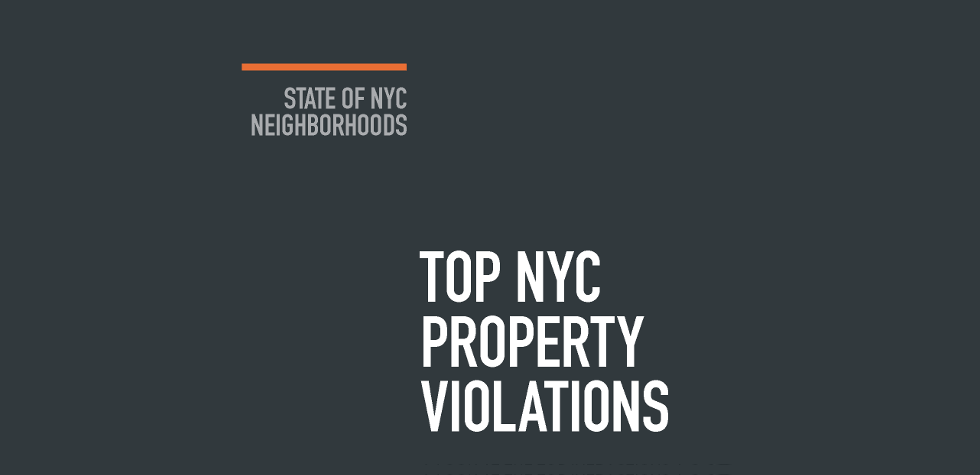Top NYC Property Violations
For the SiteCompli team, compliance data isn’t just about tallying numbers. It’s about analyzing trends, and more importantly, understanding how we can help owners and managers protect against those trends.
Anecdotally, we heard a lot from clients about how they felt certain violations were being issued more frequently over the past few years. We decided to take a deeper look at the data, reviewing violation issue rates across a random sampling of 300,000 properties for several different agencies (ECB, HPD, FDNY, and the DSNY). The results were more than just a feeling – here’s what we found across the city:
The Environmental Control Board
ECB-related violation issuances in all boroughs saw a jump in 2009, and stabilized somewhat in the years following. That said, violation counts in Manhattan, the Bronx, Brooklyn, and Queens are once again on the rise, showing greater numbers of issued infractions from 2015 to 2016.
The highest average violation count belongs to Manhattan properties with 100-plus units, coming in at 7.51 new violations per building, per year. The Bronx isn’t far behind, with the next highest averages (between 6.2 and 6.6) belonging to buildings with 26—99 units. Brooklyn and Queens get the least amount of ECB-related violations on average, not topping 4.9 violations per year for any sized building.
While the above reflect average counts for all violations issued in conjunction with ECB hearings, the next sets of data reflect specific agency violations (and show some interesting patterns in boroughs you may not have expected).
The Department of Sanitation
In four of five boroughs, one specific infraction saw the biggest increase from 2015 to 2016: infractions for failure to clean 18 inches Into the street increased as much as 125 percent from the previous year. In fact, the amount of issuances for this violation doubled in 2016 in Manhattan alone. The data shows that DSNY inspectors are looking for and enforcing this specific regulation. Make sure your team avoids these violations by cleaning into the street before your designated daily inspection periods.
In addition, violations with the highest increase all related to exterior cleaning—dirty area and dirty sidewalk infractions saw some of the highest issue rates in 2016. With all the focus on separating and securing trash and recyclables, it’s important to remember to have a clean exterior, as well. That said, new commercial recycling regulations are now in effect and enforceable—we may see an increase in infractions here for 2017.
Housing Preservation & Development
Out of all the agencies SiteCompli reviewed, HPD was the only one that had inconsistent increase patterns. Some boroughs saw increases from 2015 to 2016 in specific classes, while others actually saw decreased violation numbers.
The largest increase was seen in the Bronx, where Class B violations grew over 15 percent, easily making the highest tally of HPD violations issued in 2016 overall. Brooklyn saw similar numbers, followed by Manhattan and Queens. Staten Island saw the lowest amount of HPD-related violations, accounting for less than 1 percent of all HPD violations issued in 2016.
Across all boroughs, two HPD violation codes (order numbers) frequently appeared: 508 (“Repair the broken or defective plastered surfaces and paint in a uniform color”) and 780 (“Failure to submit annual registration”). The latter is easy to prevent—make sure you’re registered before September 1st annually (or if you missed the deadline, complete and submit your registration ASAP).
FDNY Notices of Violation
While several violating conditions (VCs) can be cited on one Notice of Violation, these VCs stood out in 2016 for seeing the biggest increase:
- BF 35 (VC 12) – Failure to prevent unnecessary/unwarranted alarms; increases ranging from 6 to 27 percent in most boroughs
- BF 20 (VC 20) – Inspection and Testing; increases from 7 to 35 percent across all boroughs
- BF 17 (VC 17) – Certificates of Fitness and Qualification; moderate increases in Brooklyn & the Bronx (3 – 20 percent) and massive 47 percent increases in Queens and 99 percent increases in Staten Island
Bottom line with the FDNY? Make sure your team is fully certified, your equipment is in good working condition, and your inspections and permits are up-to-date.
We’ll be taking another look at the data after the next few months, when 2017 comes to a close. Until then, you can check out our full analysis and report at sitecompli.com/blog.
Kristen Hariton, Senior Product Marketing Manager
SiteCompli
45 West 25th St., 3rd Floor
New York, NY 10010
Kristen.hariton@sitecompli.com
646-257-4250















Add Comment